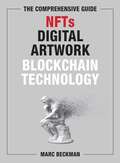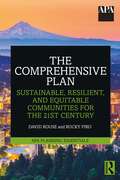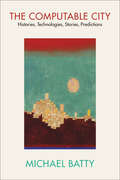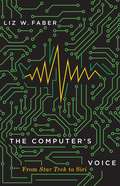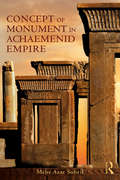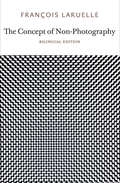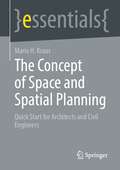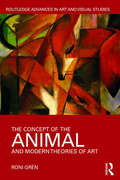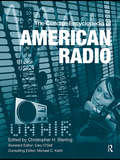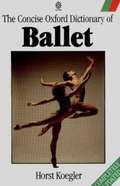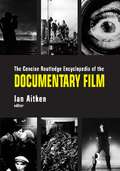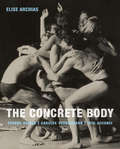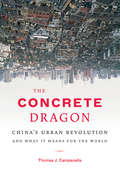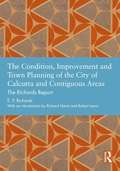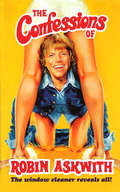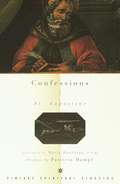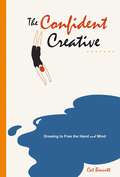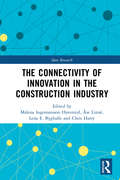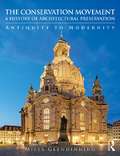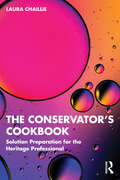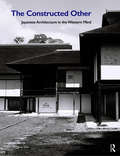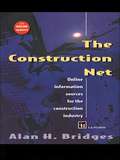- Table View
- List View
The Comprehensive Guide to NFTs, Digital Artwork, and Blockchain Technology
by Marc BeckmanThe ultimate guide to the NFT revolution: How non-fungible tokens are poised to transform the digital world. Non-fungible tokens, or NFTs, are the most important digital innovation since the creation of blockchain and cryptocurrency. NFTs share the best elements of both of these, while also representing an entirely new step forward for technology. But how did NFTs arise, how will they impact art and business in the decades to come, and—perhaps most importantly—how can savvy entrepreneurs position themselves today for success in the NFT-driven world of tomorrow? This guide by industry leader and entrepreneur Marc Beckman delves into the underpinnings of NFT technology in a way that makes the subject clear and comprehensible to the layman, while drawing on Marc&’s branding experience to explore exactly how NFTs are poised to change fashion, sport, fine art, and even social justice. In this book he explores how NFTs will create entirely new asset classes and investment possibilities, such as fractional ownership in dynamic works of art. And in doing so, he also tells the story of how he personally discovered and became entranced by this powerful new tool, and where he believes NFTs will take business and branding throughout the 21st century.
The Comprehensive Plan: Sustainable, Resilient, and Equitable Communities for the 21st Century (APA Planning Essentials)
by Rocky Piro David RouseThe practice of comprehensive planning is changing dramatically in the 21st century to address the pressing need for more sustainable, resilient, and equitable communities. Drawing on the latest research and best practice examples, The Comprehensive Plan: Sustainable, Resilient, and Equitable Communities for the 21st Century provides an in-depth resource for planning practitioners, elected officials, citizens, and others seeking to develop effective, impactful, comprehensive plans, grounded in authentic community engagement, as a pathway to sustainability. Based on standards developed by the American Planning Association to provide a national benchmark for sustainable comprehensive planning, this book provides detailed guidance on the substance, process, and implementation of comprehensive plans that address the critical challenges facing communities in the 21st century.
The Computable City: Histories, Technologies, Stories, Predictions
by Michael BattyHow computers simulate cities and how they are also being embedded in cities, changing our behavior and the way in which cities evolve.At every stage in the history of computers and communications, it is safe to say we have been unable to predict what happens next. When computers first appeared nearly seventy-five years ago, primitive computer models were used to help understand and plan cities, but as computers became faster, smaller, more powerful, and ever more ubiquitous, cities themselves began to embrace them. As a result, the smart city emerged. In The Computable City, Michael Batty investigates the circularity of this peculiar evolution: how computers and communications changed the very nature of our city models, which, in turn, are used to simulate systems composed of those same computers.Batty first charts the origins of computers and examines how our computational urban models have developed and how they have been enriched by computer graphics. He then explores the sequence of digital revolutions and how they are converging, focusing on continual changes in new technologies, as well as the twenty-first-century surge in social media, platform economies, and the planning of the smart city. He concludes by revisiting the digital transformation as it continues to confound us, with the understanding that the city, now a high-frequency twenty-four-hour version of itself, changes our understanding of what is possible.
The Computer's Voice: From Star Trek to Siri
by Liz W. FaberA deconstruction of gender through the voices of Siri, HAL 9000, and other computers that talk Although computer-based personal assistants like Siri are increasingly ubiquitous, few users stop to ask what it means that some assistants are gendered female, others male. Why is Star Trek&’s computer coded as female, while HAL 9000 in 2001: A Space Odyssey is heard as male? By examining how gender is built into these devices, author Liz W. Faber explores contentious questions around gender: its fundamental constructedness, the rigidity of the gender binary, and culturally situated attitudes on male and female embodiment.Faber begins by considering talking spaceships like those in Star Trek, the film Dark Star, and the TV series Quark, revealing the ideologies that underlie space-age progress. She then moves on to an intrepid decade-by-decade investigation of computer voices, tracing the evolution from the masculine voices of the &’70s and &’80s to the feminine ones of the &’90s and &’00s. Faber ends her account in the present, with incisive looks at the film Her and Siri herself.Going beyond current scholarship on robots and AI to focus on voice-interactive computers, The Computer&’s Voice breaks new ground in questions surrounding media, technology, and gender. It makes important contributions to conversations around the gender gap and the increasing acceptance of transgender people.
The Concept of Monument in Achaemenid Empire
by Mehr Azar SoheilThe aim of this book is to explore the significance of the concept of ‘monument’ in the context of the Achaemenid Empire (550-330 BC), with particular reference to the Royal Ensemble of Persepolis, founded by Darius I and built together with his son Xerxes. While Persepolis was built as an ‘intentional monument’, it had already become an ‘historic monument’ during the Achaemenid period. It maintained its symbolic significance in the following centuries even after its destruction by Alexander of Macedonia in 330 BC. The purpose of building Persepolis was to establish a symbol and a common reference for the peoples of the Empire with the Achaemenid Dynasty, transmitting significant messages and values such as peace, stability, grandeur and praise for the dynastic figure of the king as the protector of values and fighting falsehood. While previous research on Achaemenid heritage has mainly been on archaeological and art-historical aspects of Persepolis, the present work focuses on the architecture and design of Persepolis. It is supported by studies in the fields of archaeology, history and art history, as well as by direct survey of the site. The morphological analysis of Persepolis, including the study of the proportions of the elevations, and the verification of a planning grid for the layout of the entire ensemble demonstrate the univocal will by Darius to plan Persepolis following a precise initial scheme. The study shows how the inscriptions, bas-reliefs and the innovative architectural language together express the symbolism, values and political messages of the Achaemenid Dynasty, exhibiting influence from different lands in a new architectural language and in the plan of the entire site.
The Concept of Non-Photography: Bilingual
by Francois LaruelleA rigorous new thinking of the photograph in its relation to science, philosophy, and art, so as to discover an essence of photography that precedes its historical, technological, and aesthetic conditions. If philosophy has always understood its relation to the world according to the model of the instantaneous flash of a photographic shot, how can there be a “philosophy of photography” that is not viciously self-reflexive? Challenging the assumptions made by any theory of photography that leaves its own “onto-photo-logical” conditions uninterrogated, Laruelle thinks the photograph non-philosophically, so as to discover an essence of photography that precedes its historical, technological and aesthetic conditions. The Concept of Non-Photography develops a rigorous new thinking of the photograph in its relation to science, philosophy, and art, and introduces the reader to all of the key concepts of Laruelle's “non-philosophy.”
The Concept of Space and Spatial Planning: Quick Start for Architects and Civil Engineers (essentials)
by Mario H. KrausSpace is an ambiguous and sometimes controversial term. Spatial planning is based on a delicate and changeable social balance, which is reflected in the legal basis (with German law code as example) and everyday implementation. In this essential, approaches from phenomenology are used to classify the various concepts of space.
The Concept of the Animal and Modern Theories of Art (Routledge Advances in Art and Visual Studies)
by Roni GrénThis book examines the importance of the animal in modern art theory, using classic texts of modern aesthetics and texts written by modern artists to explore the influence of the human-animal relationship on nineteenth and twentieth century artists and art theorists. The book is unique due to its focus on the concept of the animal, rather than on images of animals, and it aims towards a theoretical account of the connections between the notions of art and animality in the modern age. Roni Grén’s book spans various disciplines, such as art theory, art history, animal studies, modernism, postmodernism, posthumanism, philosophy, and aesthetics.
The Concise Encyclopedia of American Radio
by Christopher H. SterlingThe average American listens to the radio three hours a day. In light of recent technological developments such as internet radio, some argue that the medium is facing a crisis, while others claim we are at the dawn of a new radio revolution. The Concise Encyclopedia of American Radio is an essential single-volume reference guide to this vital and evolving medium. It brings together the best and most important entries from the three-volume Museum of Broadcast Communications Encyclopedia of Radio, edited by Christopher Sterling. Comprised of more than 300 entries spanning the invention of radio to the Internet, The Concise Encyclopedia of American Radio addresses personalities, music genres, regulations, technology, programming and stations, the "golden age" of radio and other topics relating to radio broadcasting throughout its history. The entries are updated throughout and the volume includes nine new entries on topics ranging from podcasting to the decline of radio. The Concise Encyclopedia of American Radio include suggestions for further reading as complements to most of the articles, biographical details for all person-entries, production credits for programs, and a comprehensive index.
The Concise Focal Encyclopedia of Photography: From the First Photo on Paper to the Digital Revolution
by Michael R. Peres Mark Osterman Grant B. R Omer Nancy M. Stuart J. Tomas LopezDefining photography is impossible. Revealing it is another matter, and that's what The Concise Focal Encyclopedia of Photography does,with each turn of the page.History: The technical origins and evolution of photography are half of the story. The other half consists of the ways that cultural forces have transformed photography into a constellation of practices more diverse than any other mode of representation. Photographers can tell a more in-depth story through a photo like Dorothea Lange's "Migrant Mother" than a journalist ever could with the written word alone.Major themes and practitioners: Over 25 entries, many with supporting illustrations,examine the figures, trends, and ideas that have contributed most heavily to the history and current state of photography.Contemporary issues: The issues influencing photography today are more complex than at any other time in its history. Questions of ethics, desire, perception, digitization, and commercialization all vie for attention. Hear what the experts have to say about crucialissues such as whether or not the images we take today will last the test of time, and if so, how?When material is covered this skillfully, "concise" is no compromise. The Concise Focal Encyclopedia of Photography is packed with useful information, compellingideas, and - best of all - pure pleasure.
The Concise Oxford Dictionary of Art and Artists
by Ian ChilversMore than 2,500 alphabetical entries list key names, places, and styles in Western art from ancient Greece to the present day. The cross-referenced entries, which range from several sentences to several pages in length, include artists, painting, sculpture, graphic arts, top collectors, dealers, patrons, galleries, museums, materials, and techniques. The revised and updated 3rd edition now includes younger, contemporary artists such as Damien Hirst, Julian Schnabel, and Rachel Whiteread. Chilvers is editor of several Oxford reference books on art and literature.
The Concise Oxford Dictionary of Ballet (2nd edition)
by Horst KoeglerThis revised and updated edition of The Concise Oxford Dictionary of Ballet remains the most comprehensive one-volume reference book in the English language devoted to ballet. Over five thousand entries cover every aspect of ballet over the past four hundred years: dancers, choreographers, composers, designers, ballets, theaters, ballet schools, companies, and technical terms. This edition includes emended entries and a great many new entries.
The Concise Routledge Encyclopedia of the Documentary Film
by Ian AitkenThe Concise Routledge Encyclopedia of the Documentary Film is a fully international reference work on the history of the documentary film from the Lumière brothers' Workers Leaving the Lumière Factory (1885) to Michael Moore's Fahrenheit 911 (2004). Previously published in three volumes, entries have been edited and updated for the new, concise edition and three new entries have been added on: India, China and Africa. The Concise Routledge Encyclopedia of the Documentary Film: Discusses individual films and filmmakers including little-known filmmakers from countries such as India, Bosnia, China and others Examines the documentary filmmaking traditions within nations and regions, or within historical periods in places such as Iran, Brazil, Portugal, and Japan Explores themes, issues, and representations in documentary film including human rights, modernism, homosexuality, and World War I, as well as types of documentary film such as newsreels and educational films Elaborates on production companies, organizations, festivals, and institutions such as the American Film Institute, Ceylon Tea Propaganda Board, Hot Docs (Toronto), and the World Union of Documentary Describes styles, techniques, and technical issues such as animation, computer imaging, editing techniques, IMAX, music, and spoken commentary Bringing together all aspects of documentary film, this accessible concise edition provides an invaluable resource for both scholars and students. With film stills from key films, this resource provides the decisive entry point into the history of an art form.
The Concrete Body: Yvonne Rainer, Carolee Schneemann, Vito Acconci
by Elise ArchiasOffering an incisive rejoinder to traditional histories of modernism and postmodernism, this original book examines the 1960s performance work of three New York artists who adapted modernist approaches to form for the medium of the human body. Finding parallels between the tactility of a drip of paint and a body's reflexive movements, Elise Archias argues convincingly that Yvonne Rainer (b. 1934), Carolee Schneemann (b. 1939), and Vito Acconci (b. 1940) forged a dialogue between modernist aesthetics and their own artistic community's embrace of all things ordinary through work that explored the abstraction born of the body's materiality. Rainer's task-like dances, Schneemann's sensuous appropriations of popular entertainment, and Acconci's behaviorist-inflected tests highlight the body's unintended movements as vital reminders of embodied struggle amid the constraining structures in contemporary culture. Archias also draws compelling comparisons between embodiment as performed in the work of these three artists and in the sit-ins and other nonviolent protests of the era.
The Concrete Dragon: China's Urban Revolution and What it Means for the World
by Thomas J. CampanellaChina is the most rapidly urbanizing nation in the world, with an urban population that may well reach one billion within a generation. Over the past 25 years, surging economic growth has propelled a construction boom unlike anything the world has ever seen, radically transforming both city and countryside in its wake. The speed and scale of China's urban revolution challenges nearly all our expectations about architecture, urbanism and city planning. China's ambition to be a major player on the global stage is written on the skylines of every major city. This is a nation on the rise, and it is building for the record books.China is now home to some of the world's tallest skyscrapers and biggest shopping malls; the longest bridges and largest airport; the most expansive theme parks and gated communities and even the world's largest skateboard park. And by 2020 China's national network of expressways will exceed in length even the American interstate highway system. China's construction industry, employing a workforce equal to the population of California, has been erecting billions of square feet of housing and office space every year. But such extensive development has also meant demolition on a scale unprecedented in the peacetime history of the world. Nearly all of Beijing's centuries-old cityscape has been bulldozed in recent years, and redevelopment in Shanghai has displaced more families than 30 years of urban renewal in the United States. China's cities are also rapidly sprawling across the landscape, churning precious farmland into a landscape of superblock housing estates and single-family subdivisions laced with highways and big-box malls. In a mere generation, China's cities have undergone a metamorphosis that took 150 years to complete in the United States.The Concrete Dragon: China's Urban Revolution and What it Means for the World sheds light on this extraordinary chapter in world urban history. The book surveys the driving forces behind the great Chinese building boom, traces the historical precedents and global flows of ideas and information that are fusing to create a bold new Chinese cityscape, and considers the social and environmental impacts of China's urban future. The Concrete Dragon provides a critical overview of contemporary Chinese urbanization in light of both China's past as well as earlier episodes of rapid urban development elsewhere in the world--especially that of the United States, a nation that itself once set global records for the speed and scale of its urban ambitions.
The Condition, Improvement and Town Planning of the City of Calcutta and Contiguous Areas: The Richards Report (Studies in International Planning History)
by E. P. RichardsBy 1900 the British had undertaken various types of urban planning in their colonial territories, but the early twentieth century brought new ideas and the birth of the modern planning movement. In India these new planning ideas inspired several specialized reports after 1900, most of which drew explicitly on British, or occasionally German, ideas. The most complete of these studies was the Richards Report on Calcutta, prepared for the Calcutta Improvement Trust and published in 1914. Its major concerns included the building and widening of roads, slum clearance and improvement, legislation, and suburban planning. As background, it included written and visual documentation of living conditions, through charts, photographs, and maps. Richards emphasized that conditions in Calcutta differed greatly from those in urban Britain, and made some allowance in that regard. In general, however, his report exemplifies the attempt by British planners, along with Indian elites, to impose their vision on colonial cities. Richards’ report was well-received by leading British planners of the day. A notice in Garden Cities and Town Planning claimed that it was "the most complete report on town conditions and possibilities which has yet been issued". While the immediate impact of the report in Calcutta is moot - Richards was highly critical of the past practices of local officials, and his views were unpopular with his superiors - the Richards Reports remains a crucial insight into both the development of modern town planning and the colonial period in India.
The Confessions Of Robin Askwith
by Robin AskwithOf all the actors and personalities thrown up by that strangest of periods. The 1970s, surely Robin Askwith was one of the most 'of his time'? As star of the infamous CONFESSIONS films, as well as over 25 other movies, Askwith was huge. His cheeky, innocent face, his Mick Jagger lips and more often than not his bare arse -- he, possibly more than anyone else sums up a bygone era remembered fondly by millions. Today, Askwith is a cult figure. The CONFESSIONS films are still regular staples on British TV and around the world, especially in the Commonwealth countries. They are just as funny as they ever were -- classic camp British humour in the same language as the Carry On films. In this brilliant autobiography, the self-deprecating Askwith cuts straight to the chase, starting in the `70s as he auditions for CONFESSIONS OF A WINDOW CLEANER, moving on to CONFESSIONS OF A POP STAR and DRIVING INSTRUCTOR. His career was truly amazing and varied beyond belief. From IF. . . to NICHOLAS AND ALEXANDEF From CONFESSIONS to Zefferelli`s BROTHER SUN, SISTER MOON and Pasolini CANTERBURY TALES. He was also great friends with the late Lindsay Anderson. In the end, Robin is most famous for his sex comedies and isn't embarrassed about it one jot. It`s a rollicking ride. Hold On Tight!
The Confessions of St. Augustine
by Saint Augustine Maria BouldingSt. Augustine managed to compose, over the course of a year filled with exhausting pastoral duties, a strange work he gave the title "my confessions in thirteen books.
The Confident Creative
by Cat BennettUsing simple methods and yogic theory, this unique guide focuses on the art of drawing as a way to unblock creativity and create artistic confidence. Both practicing and beginning artists will learn to develop drawing skills, overcome creative blocks, and enter the meditative state in order to find creative connections and confidence. Featuring full-color examples from professional artists, three different drawing methods, and exercises tested and developed in the author's own drawing class, this is an invaluable tool for artists, writers, musicians, and all who wish to access their creative strengths and live inspired, authentic lives.
The Connectivity of Innovation in the Construction Industry (Spon Research)
by Malena Ingemansson Havenvid Åse Linné Lena E. Bygballe Chris HartyThe construction industry is currently experiencing accelerating developments concerning societal demands along with project complexity, internationalization and digitalization. In an attempt to grasp the consequences of these demands on productivity and innovation, this edited book addresses how innovation is likely to take place with a more long-term perspective on the construction sector. While existing literature focuses on organizational discontinuity and fragmentation as the main reasons for the apparent lack of innovation in the industry, this book highlights the connectivity of construction actors, resources and activities as fundamental for understanding how innovation takes place.Through 15 empirically grounded chapters, the book shows how innovation is part of construction processes on various levels, including project, firm and industry, and that these innovation processes are characterized by organizational and technological connectivity over time. Written by European business management scholars, the chapters cover empirical cases and examples from both a multi-organizational and a multi-international perspective in terms of covering the viewpoints of different industry actors and the contexts of several different European countries including: Sweden, Norway, the UK, Italy, France, Hungary and Poland. By illustrating how connectivity is part of innovation processes in the creation of single-product innovations, of various innovations within and across projects, as well as a fundamental aspect of the processes in which innovations cross nations, the book provides a new angle on how to understand construction innovation and where the industry might (or needs to) be heading next. This book is essential reading for anyone interested in construction management, project management, engineering management, innovation studies, business and management studies.
The Conservation Movement: Antiquity to Modernity
by Miles GlendinningWinner of the 2016 Antoinette Forrester Downing Award presented by the Society of Architectural Historians. In many cities across the world, particularly in Europe, old buildings form a prominent part of the built environment, and we often take it for granted that their contribution is intrinsically positive. How has that widely-shared belief come about, and is its continued general acceptance inevitable? Certainly, ancient structures have long been treated with care and reverence in many societies, including classical Rome and Greece. But only in modern Europe and America, in the last two centuries, has this care been elaborated and energised into a forceful, dynamic ideology: a ‘Conservation Movement’, infused with a sense of historical destiny and loss, that paradoxically shared many of the characteristics of Enlightenment modernity. The close inter-relationship between conservation and modern civilisation was most dramatically heightened in periods of war or social upheaval, beginning with the French Revolution, and rising to a tragic climax in the 20th-century age of totalitarian extremism; more recently the troubled relationship of ‘heritage’ and global commercialism has become dominant. Miles Glendinning’s new book authoritatively presents, for the first time, the entire history of this architectural Conservation Movement, and traces its dramatic fluctuations in ideas and popularity, ending by questioning whether its recent international ascendancy can last indefinitely.
The Conservator's Cookbook: Solution Preparation for the Heritage Professional
by Laura ChaillieThe Conservator’s Cookbook is a collection of practical, step-by-step guides outlining how to prepare various solutions, adhesives, gels, and other mixtures used in heritage conservation.While most conservators learn the chemical rationale of solution-making during their training, the actual process of preparing these compounds can be neglected or eventually forgotten. This “cookbook” provides a non-exhaustive and adaptable resource, compiling practical recipes from across heritage conservation literature into a single volume. Drawing from techniques used in furniture, paper, paintings, textiles, and other conservation specialisms, each “recipe” in the Cookbook begins with a short summary of key chemical ideas, before relating step-by-step instructions. The solutions range from simple dissolutions (adhesive resins), to more complex cleaning systems (utilising surfactants, chelation agents, and enzymes) and gelled carriers. Each “recipe” is followed with collections of technical data which help to bridge the gap between chemical understanding and practical application. The Cookbook also provides important notes on health and safety and laboratory best practice, addressing some common misunderstandings and encouraging more sustainable approaches. Intended for the experienced professional and conservation student alike, The Conservator’s Cookbook is a crucial reference work that provides a starting point for practical experimentation and interaction between different conservation specialisms.
The Conspiracy of Feelings and The Little Theatre of the Green Goose
by Yurii Olesha Konstanty Ildefons GałczyńskiTwo outstanding examples of socialist-themed plays are combined in this remarkable volume. The Conspiracy of Feelings by Yurii Olesha (1899-1960) is based on his highly respected short novel Envy about the struggle between the old and new in Soviet society. The play, called The Conspiracy of Feelings, is not a simple adaptation, but an original work that reconceived the novel. The play explores the precarious position of the intelligentsia in the new collective state. The Little Theatre of The Green Goose was written by Konstanty Ildefons Galczynski (1905-53) who was one of Poland's most beloved poets. After World War II, he began work as a playwright, inventing a colorful theatre troupe of performers (animal and human) and contributing a new instalment of The Little Theatre of the Green Goose each week to Przekroj, the Cracow literary magazine. Intended for reading only, The Green Goose went unperformed in Galczynski's life and was finally staged in 1955 and gained a permanent place in the theatre and became a force for the creation of the new Polish drama that flourished in the 1960s.
The Constructed Other: Japanese Architecture in the Western Mind
by Kevin NuteThe Constructed Other argues that the assumed otherness of Japanese architecture has made it both a testbed for Western architectural theories and a source of inspiration for Western designers. The book traces three recurring themes in Western accounts of Japanese architecture from the reopening of Japan in the mid-nineteenth century to the present day: a wish to see Western architectural theories reflected in Japanese buildings; efforts to integrate elements of Japanese architecture into Western buildings; and a desire to connect contemporary Japanese architecture with Japanese tradition. It is suggested that, together, these narratives have had the effect of creating what amounts to a mythical version of Japanese architecture, often at odds with historical fact, but which has exercised a powerful influence on the development of building design internationally.
The Construction Net: Online information sources for the construction industry
by Alan BridgesUsing this book can help the busy architect/engineer/contractor to optimize online time by determining the key sites to visit before connecting to the Internet. Topics are conveniently arranged by subject showing where to find the "index sites" together with details of many specialist sites.
